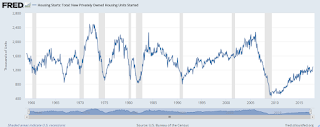| Last | Change | |
| S&P Futures | 2697.3 | 2.8 |
| Eurostoxx Index | 392.4 | -0.3 |
| Oil (WTI) | 57.4 | 0.2 |
| US dollar index | 86.9 | 0.3 |
| 10 Year Govt Bond Yield | 2.43% | |
| Current Coupon Fannie Mae TBA | 102.531 | |
| Current Coupon Ginnie Mae TBA | 103.375 | |
| 30 Year Fixed Rate Mortgage | 3.88 |
Stocks are higher as Congress begins the voting for tax reform. Bonds and MBS are down.
The House is expected to vote on tax reform this afternoon around 1:30. Depending on the procedural machinations, the Senate will vote either tonight or tomorrow. Bob Corker and Susan Collins are supposedly on board, so this should be done.
Housing starts increased to 1.3 million in November, according to Census. This is up 3.3% MOM and 13% YOY. Building Permits came in at 1.3 million as well. The increase in starts was driven by single-family, not multi, and hit a 10 year high. Note that tax reform's pass-through treatment will be good news for landlords and could encourage more multi-fam construction. We didn't see any jump in multi-fam permits last month, so maybe the change is too recent to influence behavior yet.
Minneapolis Fed Head Neel Kashkari argues that we should not be raising interest rates yet. Neel was one of 2 dissenters at the last FOMC meeting, preferring to maintain the current level of rates. His argument is that inflation remains below the Fed's target rate of 2% and there is still slack in the labor market. He also is worried about what the flattening yield curve is saying. IMO he has a point - we want the labor market to keep bringing back the long-term unemployed, however we are hardly going to a tightening posture. On a scale of 1 - 10, where 1 is easy and 10 is tight, we are going from a 1 to a 2. Real interest rates are still negative, and the Fed is still buying Treasuries and MBS albeit at a reduced pace. What would a 10 on that scale look like? The early 1980s, when Paul Volcker tightened to quell inflation and took the Fed Funds rate from 9% to 19%. We are in a different economic scenario than the late 70s, but some historical perspective is helpful.
New mortgage loan credit risk increased in the third quarter, according to CoreLogic's Housing Credit Index. The increase in risk was driven by an increase in the share of condo / multi-fam loans. Credit scores improved, while DTIs fell. We are back in the pre-bubble range of credit risk.



No comments:
Post a Comment